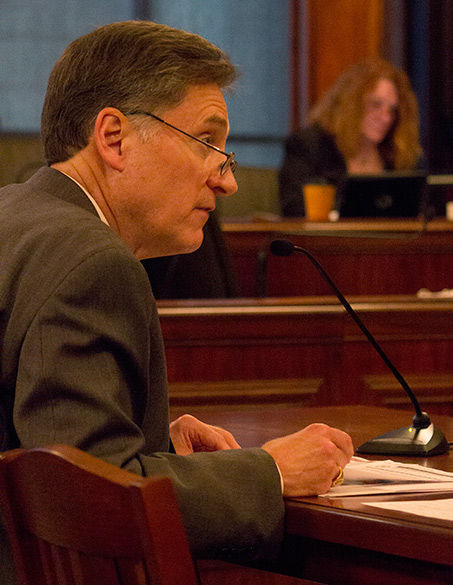Chancellor: SIUE plans for more students, less state funding

March 14, 2016
While Southern Illinois University-Edwardsville is “dying by a thousand budget cuts,” Chancellor Stephen Hansen laid out the beginnings of a plan to keep the university solvent despite continuing reductions in state support.
This year’s budget proposed a 30 percent budget cut for Southern Illinois University, and while the budget has never been approved, SIUE did a pre-emptive 9 percent budget cut in anticipation of a compromise. The budget proposed for next year includes a 20 percent cut, however, and in the meantime, SIUE has continued operating for eight months with no appropriations whatsoever.
MORE: SIUE could see cuts topping $14 million under 2017 budget
Advertisement
Hansen directed a “congress” of staff, students and faculty to work on long-term solutions and priorities, including the faculty and staff Senates, student government, administrators and others, with more than 200 people meeting in three sessions for “vigorous discussion,” he said.
One of the biggest questions faced by the university was whether they should continue to grow enrollment while operating with fewer state resources. SIUE’s general goal has been to increase enrollment approximately 1 percent a year, and they have usually met that goal.
The conclusion was a strong yes, Hansen said, that the university should continue to grow its student body. But that also means updating capacity studies and re-evaluating program priorities, finding better ways to use space and scheduling to prepare for more students with less funding.
MORE: University announces massive potential program cuts, layoffs due to budget issues
Addressing that funding is another issue. While raising tuition is on the table, Hansen said it could not cover the shortfall alone.
“We could not balance the books on the backs of the students and the parents,” Hansen said. “We can’t raise tuition enough to make up for [the loss of funding].”
Increased enrollment helps with the cash flow, but Hansen said they also will be looking at better ways to monetize the university’s assets and land and increase gift-giving.
Advertisement*
Internally, SIUE will be looking to adopt a different budget model to give the departments more flexibility, create more student success initiatives for at-risk students, and to revise its curriculum for quality and efficiency.
“As resources decline, one of the first things that happens is that quality comes into question,” Hansen said. “We need to work vigorously on improving the quality of our programs.”
Among the curriculum issues is expanding online learning, which is a fast-growing component of SIUE’s programming.
Also in attendance was SIU President Randy Dunn, who testified last week before the state Senate Appropriations Committee in what is usually “making the case” for the budget requests. This time, Dunn said, the direction was more toward “political philosophizing.”
“Each of the university presidents were in a bit of a position of being in the cross hairs, as each side staked out its political position,” Dunn said. “It was important to be there to carry the flag for SIU…. But I don’t know that what we said moved the needle much.”
Dunn said at this point late in the fiscal year, the universities aren’t looking so much for a full budget as for a “patch,” an appropriation that gives them some funding to make up for the funds they’ve borrowed or shifted to cover for the lack of state funding.
Dunn reiterated that neither campus is in danger of closing or suspending operations, but that the changes that would have to be made under some of the proposals will make it a very different institution in the future. Shortly before his testimony, SIU released a plan to cope with the proposed 20 percent reduction in the FY17 budget. It included layoffs at SIUE for the first time; while Carbondale had a furlough in 2011 and has laid off some people in grant-funded positions.
Both campuses extended coverage for state MAP grants to low-income students this year despite the lack of appropriation for the MAP grants. Both the Democratic and Republican budgets included funding for MAP grants at or above its current levels, but a bill releasing those funds was vetoed last month and a veto override failed, which Dunn said was “disappointing.”
“We wanted to see that override pass because it would have put students at the front of the line and would have been at least part of this ‘patch’ to push some cash out to the state universities,” Dunn said.
As for fall 2016, Dunn said the issue of whether SIU can continue to cover the MAP grants without reimbursement is “a matter of serious discussion,” but has not been decided yet. It’s possible that it might be covered in Edwardsville and not covered in Carbondale, he said, as the latter campus has had a problem with declining enrollment.
“We’re likely to do a lot of zigs and zags, and it will require a lot of perseverance,” Hansen said. “We’re setting the stage for SIUE to continue to thrive, not just survive… We are responsible for the stuff of which the dreams of thousands of students are made, and you know what? It’s pretty damn good stuff.”
Elizabeth Donald: 618-239-2507, @BNDedonald
___
(c)2016 the Belleville News-Democrat (Belleville, Ill.)
Visit the Belleville News-Democrat (Belleville, Ill.) at www.bnd.com
Distributed by Tribune Content Agency, LLC.
Advertisement








